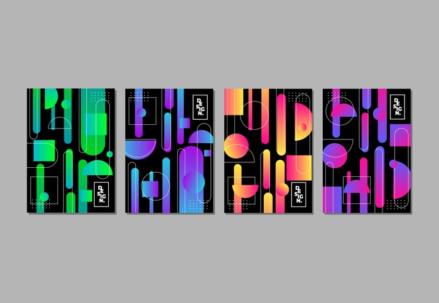In the ever-evolving realm of creative industries, roles and titles often overlap, leading to confusion about who does what. In the world of visual communication and design, three key positions often find themselves at the heart of creative endeavors: the Art and Creative Director, and the Graphic Designer. While these titles may sound similar, they represent distinct roles with unique responsibilities and skill sets. Understanding the differences between these roles is essential for anyone navigating the dynamic landscape of creative work, whether you’re an aspiring designer, a client seeking creative services, or simply curious about the inner workings of the creative process. In this article, we’ll delve into the nuances that set apart Art, Creative Directors, and Graphic Designers, shedding light on their individual contributions to the world of visual storytelling and design.
Expanding the Role of Graphic Designers
Graphic designers stand as pivotal pillars in the intersection of visual art and communication, crafting an array of print and digital media to transmit compelling messages. These visual communicators are versed in a multitude of principles, extending far beyond the basics. Here’s a deeper look into the breadth of their expertise:
- Digital Illustration and Rendering: Mastering the art of transforming sketches into polished digital images, graphic designers adeptly bring concepts to life, including the meticulous crafting of logos;
- Typography Mastery: The choice of typeface is far from arbitrary; it’s an essential component of visual communication. Graphic designers match the tone and context of the message with the perfect font to enhance readability and emotional impact;
- Color Theory: An understanding of which hues complement or contrast each other allows these artists to create visually harmonious designs, eliciting the desired response from the viewer;
- Layout and Composition: Mastery in arranging visual elements on print and web media, balancing the elements of contrast, repetition, alignment, and proximity, ensures the clarity and aesthetic of the final product;
- Tool Proficiency: Graphic designers are equally comfortable sketching with traditional mediums like pens and pencils as they are with using sophisticated software such as Adobe Creative Suite to execute their vision;
- Product Diversification: Their portfolio often includes a versatile range of items such as posters, brochures, books, and websites, each tailored with a unique message and purpose in mind.
The role of graphic designers is dynamic, requiring a blend of creativity and strategic thinking. They are the artisans of the digital realm, interpreting and molding ideas into visual stories. In the U.S., these professionals command a respectable median salary, reflecting the value of their specialized skill set in the marketplace.
The Distinctive Roles of Art Directors and Creative Directors
When delineating the roles within the visual arts hierarchy, the distinctions between an Art Director and a Creative Director are crucial.
Art Director: This role is akin to an orchestra conductor, guiding the various players — graphic designers, copywriters, and photographers — to ensure a harmonious and coherent output. Art Directors strategize the visual approach and direct the project’s aesthetic journey, ensuring consistency with the brand’s ethos. Their oversight spans the full lifecycle of a project, from initial conception to the final stages of production and distribution. Should the position of Creative Director be absent, the Art Director steps in as the project’s visionary lead.
Key insights into an Art Director’s responsibilities include:
- Steering brainstorming sessions and conceptual development;
- Synchronizing the creative team’s efforts to maintain a unified brand voice;
- Managing project workflows to meet milestones and delivery dates.
Creative Director: Meanwhile, the Creative Director is the ideator, the origin of the creative spark. Their realm is the birthplace of innovative concepts and overarching campaign strategies. They are less involved in the hands-on process of design and more focused on overarching vision and strategic direction. In some instances, a Creative Director may also helm the organization, akin to a CEO, safeguarding the studio’s design ethos and ensuring the end product aligns with client expectations. The Creative Director’s purview extends over the entire team, framing the broad creative narrative that the Art Director and Graphic Designer will then flesh out.
A deeper look into a Creative Director’s role reveals:
- Ideation and high-level concept development;
- Strategic planning and guiding the brand’s creative journey;
- Leading the creative team and making executive decisions regarding client presentations and creative outputs.
Exploring the Role of an Art Director
An Art Director stands at the helm of a creative project, orchestrating a symphony of talents to transform a mere concept into a tangible masterpiece. This role is distinct and more comprehensive in scope compared to that of a Graphic Designer, who primarily focuses on crafting visual content using a blend of technical proficiencies in design software and understanding of design principles.
- Multidisciplinary Leadership: An Art Director leads a diverse team, ranging from Illustrators and Photographers to UI/UX Designers, ensuring that each member’s unique abilities coalesce to realize a unified vision;
- Industry Versatility: Far beyond the confines of digital or print media, Art Directors often venture into the dynamic realms of fashion, theater, and film. Here, they act as visual storytellers, conceptualizing the aesthetics that will eventually set stages ablaze and capture the audience’s imagination;
- Strategic Delegation: Unlike Graphic Designers who delve into the nuances of design themselves, Art Directors typically oversee the creative process, delegating specific tasks to specialists like Website Developers, Printers, and even Makeup Artists to achieve the desired outcome;
- Financial Insights: In the bustling creative hub of New York, the year 2015 saw Art Directors earning a median annual salary of $115,880, reflecting the high demand and significant responsibility carried by professionals in this role.
The Creative Process: Conception to Realization
The creative journey an Art Director undertakes is meticulously divided into two critical phases:
- Conception: This phase is characterized by intense brainstorming, where innovative ideas are born through collaboration with Copywriters and other creatives. It’s a melting pot of imagination, where the seeds of inspiration are sown;
- Execution: Following the birth of an idea, an Art Director meticulously coordinates with Graphic Designers and other creatives to breathe life into the concept. It involves:
- Task Allocation: Judiciously distributing responsibilities to harness each team member’s strength;
- Goal Alignment: Ensuring that every visual or artistic output aligns seamlessly with the overarching objectives;
- For Art Directors, Graphic Design is a vital cog in the larger mechanism they oversee. It’s about maintaining a balanced ecosystem where each creative element interlocks perfectly with the next.
The Broader Perspective: Beyond Art Direction
While Art Directors are maestros within their domain, Creative Directors adopt an even broader vantage point. They are visionaries who focus on the grander narrative, shaping the entire creative strategy of campaigns or organizations. Creative Directors are tasked with the mission to not only oversee individual projects but to steer the creative identity of a brand or entity across multiple platforms and mediums, ensuring a consistent and impactful message.
- Visionary Scope: They chart the course for a brand’s creative voyage, anticipating trends and setting creative benchmarks;
- Brand Storytelling: Creative Directors knit together the various creative disciplines to tell a brand’s story in the most compelling way.
The Role and Career Trajectory of a Creative Director
Career Beginnings
Individuals who ascend to the role of a Creative Director often have their professional origins in various creative niches. These can include, but are not limited to:
- Graphic Design;
- Art Direction;
- Copywriting.
Their vocational journey may have roots in a spectrum of dynamic sectors such as event management, the visual arts, or the film industry. The path is diverse and fosters a rich amalgamation of experiences and skills.
Industry Spectrum
Creative Directors are found spearheading initiatives across a multitude of sectors. Each industry presents unique challenges and opportunities for creative leadership:
- Event Planning: Orchestrating memorable experiences through visual storytelling and thematic consistency;
- Visual Arts: Steering the aesthetic and conceptual direction of galleries and installations;
- Film and Media: Guiding the narrative and visual essence of cinematic projects.
Expansive Scope of Work
In contrast to an Art Director, who may focus primarily on the visual elements within an organization, the scope of a Creative Director stretches into the broader strategic realm. Their primary concern lies in two pivotal areas:
- Client Retention: Cultivating lasting relationships through consistent delivery of innovative and effective design solutions;
- Business Expansion: Spearheading growth through strategic creative development that attracts and engages new clientele.
Core Responsibilities
The quintessential tasks of a Creative Director blend various elements of communication and design strategy:
- Messaging Strategy: Crafting the core messages that resonate with target audiences;
- Copywriting and Editing: Articulating brand voices through compelling written content;
- Artistic Oversight: Supervising visual aesthetics across all platforms;
- Media Strategy: Ensuring the brand’s presence is optimized across traditional and digital media outlets;
- Creative Directors act as the linchpin between a company’s marketing ambitions and the creative execution. They meticulously transform marketing objectives into actionable creative strategies, often juggling multiple projects and leading teams of Art Directors to accomplish this.
Intuitive and Psychological Insights
The mastery of a Creative Director lies not just in their creative output but in their deep understanding of consumer psychology and design intuition. They:
- Analyze trends and consumer behavior to develop intuitive design strategies;
- Employ psychological insights to craft messages that strike a chord with audiences.
Skills Beyond Creativity
While a Creative Director’s primary strength may not always lie in technical prowess, there is an expectation for them to possess a versatile skill set. They should be capable of:
- Writing persuasive copy when needed;
- Designing basic visual elements such as logos;
- Selecting appropriate typefaces and design elements to complement brand messaging.
Financial Outlook
As of the first quarter of 2017, Creative Directors in the United States reported a median annual salary of approximately $114,937. Yet, remuneration is subject to fluctuate based on various factors:
- The size of the employing company;
- The specific industry within which they operate;
- Geographical location and cost of living adjustments.
Distinguishing Creative Directors from Design and Art Directors
Vision Implementation
The Creative Director’s vision is not always bound by the need for technical design skills or hands-on managerial prowess characteristic of Graphic Designers or Art Directors, respectively. Instead, they often:

- Leverage their team’s expertise to bring creative concepts to fruition;
- Focus on aligning team talents with the client’s business goals;
- Encourage collaborative problem-solving to ensure a project’s success.
Meeting Business Objectives
A hallmark of an accomplished Creative Director is the ability to navigate the intersection of creativity and commerce. They:
- Interpret and integrate the client’s business objectives into the creative process;
- Work closely with team members to ensure that creative decisions bolster the client’s bottom line;
- Prioritize strategic thinking to ensure that creative campaigns are not only aesthetically pleasing but also commercially viable.
In essence, the Creative Director serves as the architect of a brand’s creative strategy, mapping out the path from concept to market impact, always with an eye on elevating the brand’s position and maximizing client satisfaction.
Conclusion
Ultimately, recognizing the differences between these roles can help individuals choose the right career path within the design industry and foster better collaboration and understanding within creative teams. Whether you aspire to be an Art and Creative Director, or a Graphic Designer, each role offers its own set of challenges and rewards, contributing to the vibrant and ever-evolving world of visual design.





